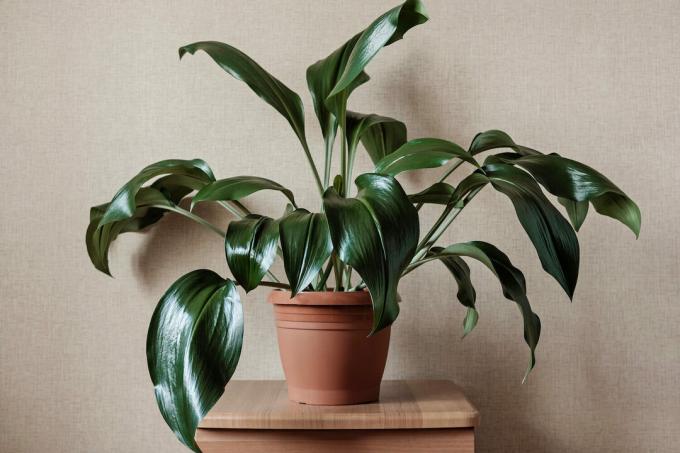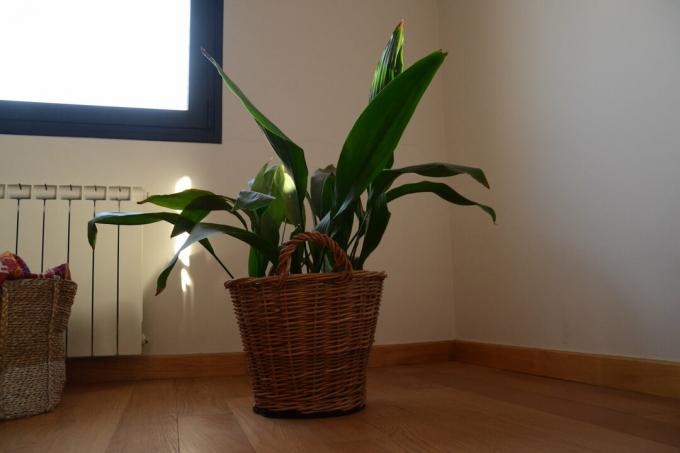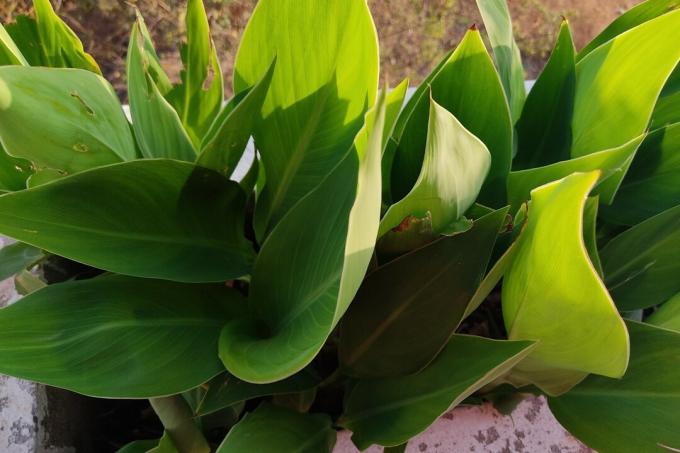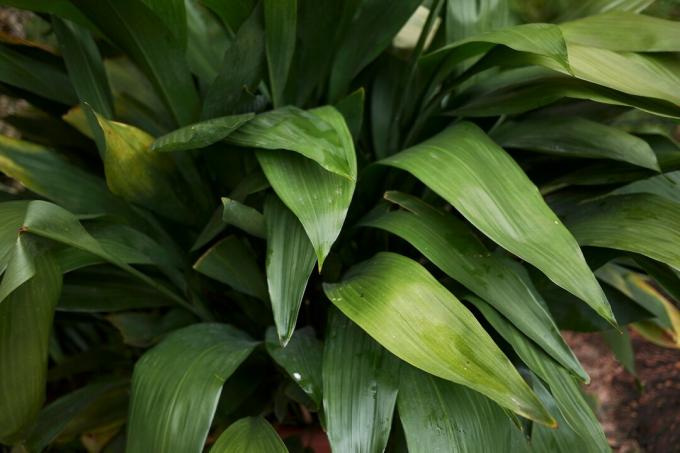The cobbler palm is considered an indestructible houseplant. The different types and varieties are therefore also ideal as starter plants.

Despite the external similarity, the cobbler's palm (Aspidistra) nothing to do with a palm tree. But it is just as popular as a houseplant in the home and office. Here you can find out everything about the location, care and propagation of Aspidistra.
contents
- Cobbler palm: flower, origin and properties
- The most beautiful types and varieties
- Planting the cobbler palm: location, soil and procedure
-
Care of the shoemaker palm
- Water, cut and fertilize
- Cobbler palm gets yellow leaves: you can do that
- Propagate shoemaker palm
- Is the cobbler palm poisonous?
Cobbler palm: flower, origin and properties
At the cobbler's palm (Aspidistra) is a genus of plants native to the tropics and subtropics of East Asia. It belongs to the asparagus family (Asparagaceae) and includes around 140 species, of which only a few can also be kept as a houseplant. The most well-known is
Aspidistra elatior. It is also known as the butcher palm or iron plant because it is very robust and easy to care for and is considered indestructible. The dark green leaves sit on long petioles that grow out of the rhizome and are not attached to a stem. The herbaceous, evergreen plant can reach sizes of 80 centimeters and grows slowly. In nature, the cobbler's palm forms bell-shaped flowers, which are often difficult to see. They grow very close to the ground as the flower stalks are extremely short. This is also the reason why snails are used as pollinators in the cobbler palm. In the room comes Aspidistra very rarely in bloom.
The most beautiful types and varieties
There are still various types of cobbler palms, but they cannot be kept as houseplants. We therefore present some varieties that are bred by Aspidistra elatior have emerged.
- Aspidistra elatior 'Variegata': This variety of cobbler palm has green leaves variegated or striped with white.
- Aspidistra elatior 'Asahi': The white color also plays a role here. The tips of the leaves appear painted white, the rest of the leaf is green.
- Aspidistra elatior 'Lennon's Song': The leaves of this variety stand out due to their light midrib.
- Aspidistra caespitosa:This species has much narrower leaves than Aspidistra elatior. These are about 2 cm wide and up to 60 cm long.
- Aspidistra lurida 'ginga':The also under the name Aspidistra elatior 'Milky Way' has green foliage leaves that are finely sprinkled with white.

Planting the cobbler palm: location, soil and procedure
The cobbler palm has no special requirements in terms of location and care. It doesn't matter whether you want to keep the cobbler's palm in the bathroom or in the bedroom, it actually feels at home everywhere. It likes light or semi-shade, but can also stand in a shady place without any problems. It is therefore also suitable as a Plant for dark rooms. Direct sun can damage the leaves. If you have a variety with white-patterned leaves, it needs a little more light to keep its color. The cobbler palm wants to be warm all year round. Temperatures of around 20 °C are ideal, but it can also be a little warmer. Lower temperatures are also tolerated, but it should not get colder than 8 °C in winter either. If it is warm enough in summer, the cobbler palm likes to stand outside in a sun-protected place. Since it is not hardy, it is essential to bring it back indoors when the temperature drops.

When planting, you should make sure that the pot has a drainage hole. Fill in a layer of expanded clay or pottery shards to allow the water to drain. This prevents the formation of waterlogging. A high-quality potting soil that can store water well is suitable as a substrate for the cobbler palm. Here, for example, is ours Plantura organic universal soil from herbal ingredients. It contains no peat and can store water and nutrients, which are then released to the plants. If you mix in a third of sand, this increases the permeability even more.
Care of the shoemaker palm
The cobbler palm care is very uncomplicated, since the plant does not make any special demands. A little water and fertilizer are enough for the cobbler palm to feel comfortable. Occasionally the leaves should be wiped with a damp cloth to keep them shiny.
Water, cut and fertilize
Water the shoemaker's palm regularly when the substrate has dried again by a third. Rainwater or stagnant tap water should be used so that no excess lime builds up. Give enough water without waterlogging. Drained irrigation water should be removed from the saucer. If you ever forget to water, there is no need to worry. The cobbler palm is frugal and forgives most care mistakes. Of course, it should not be completely neglected.
There is no need to prune the cobbler palm. If leaves are changing color, you can cut them off once they are completely withered. Use a sharp tool and cut off the leaf at the base. Never cut in the middle of the plant, as this is where the new leaves are formed. The cobbler palm can also be cut without any problems to use the shiny leaves in bouquets or arrangements.
tip: Only with the 'Variegata' variety should those leaves be removed that are only green and have no white parts. Otherwise it can happen that at some point only green leaves are formed.

Compared to other plants, the shoemaker palm does not have a very high nutrient requirement, but should still be fertilized regularly. A fertilizer application once a month is sufficient during the growing season. It is best to use a liquid fertilizer for indoor plants, such as ours Plantura organic room and green plant fertilizer, which you can simply mix into the irrigation water. With its nutrient composition, it is perfect for almost all green indoor plants and ensures healthy leaves and roots.
You can repot the cobbler palm every three to four years in spring. Use a larger pot to give them enough room for their roots.
Is the cobbler palm hardy?
The cobbler palm is not hardy and does not tolerate temperatures below 8 °C. Nevertheless, it can be a little colder in winter at approx. 10 – 12 °C. During this dormant phase, you can also water less and the plant will only grow more slowly. The cobbler palm is not fertilized in winter.

Cobbler palm gets yellow leaves: you can do that
If the shoemaker palm gets yellow leaves or brown leaves appear, incorrect watering is often the cause.
- waterlogging: Waterlogging causes root rot, which manifests itself in brown or yellow discolored leaves. Then repot the cobbler palm in fresh substrate and give it less water.
- Calcareous water: The lime content in the water can also lead to leaf discoloration, so-called lime chlorosis. Be sure to use low-lime water, such as rainwater.
- direct sun: Individual brown spots on the leaves can also be caused by too much direct sunlight. The cobbler palm then needs a more shady place.
Propagate shoemaker palm
To propagate the cobbler palm, it is best to divide the mother plant. The best time is spring. Lift the plant out of the pot and separate the rhizomes with your hands or with a knife. Make sure each part has at least two leaves. Then plant the cobbler palms separately, or plant several together in a pot for a bushier appearance. The temperature should be around 15 °C at the beginning. The separated cobbler palms should be cared for like the mother plant, but not fertilized at first so that the roots develop vigorously.

Unfortunately, it is hardly possible to propagate the shoemaker palm from seeds in our latitudes. Seed is almost never traded. Since the plant only rarely flowers and then does not produce any fruit, it is almost impossible to produce your own seeds.
Is the cobbler palm poisonous?
According to the current state of knowledge, the shoemaker palm is not poisonous, neither for humans nor for pets.
There's more shade-loving houseplants, for which you are guaranteed to find a suitable place in every apartment. We present the ten most beautiful.
